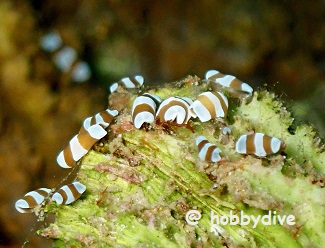Loading content - please wait...
Banded Amphiscolops flatworms throw a party
Banded Amphiscolops flatworms are an undescribed species and rarely seen. However, during a check dive in Gorontalo, divers encountered dozens of them.
It’s a Party
Miguel’s Diving staff has encountered this rare marine creature less than five times over the two decades we have dived Gorontalo’s biodiverse waters. In previous encounters, only three to five individuals were present. Those Banded Amphiscolops flatworms stayed on the same coral head for several weeks before disappearing from view. They never returned to that spot. In November, 2022, divers from HobbyDive Jakarta were delighted at such a rare encounter. The mystery remains as to why so many of these flatworms gathered. A close inspection of a photo taken during the dive clearly shows them grazing. What they are eating is unclear. However, researchers know that other species of acoel flatworms feed on detritus, diatoms, and tiny crustaceans, especially copepads.
Banded Amphiscolops flatworms
Flatworms are bilaterally symmetrical. Plus, their bodies are soft and flattened, hence the name. Typically, microscopic cilia will protrude from their skin. These are movable hairs. Those on the ventral or underside of the flatworm will move the creature along.
Amphiscolops is a genus of acoel flatworms. Acoel derives from Greek words that mean “no cavity.” Acoel flatworms lack a fluid-filled body cavity. Also, they lack respiration. However, species do have various sensory organs that can only be detected by microscope. Acoel flatworms reproduce via two methods, depending on the species. Most can reproduce by fragmentation. When part of this type of flatworm breaks off, it will grow to become a separate individual. Other acoel flatworks can reproduce sexually.
Since Banded Amphiscolops flatworms are an undescribed species, no one yet know how they reproduce. No one knows why they suddenly congregated in numbers, only to disappear again. When an Amphiscolops flatworm stretches out, its head will be obvious since its tail will appear slightly forked. In the photos we have of Banded Amphiscolops flatworms, they usually appear rounded with their edges rolled in. Perhaps this is part of their feeding behavior. However, close inspection of individuals reveals the slightly forked tail. The end that is not forked will be the head.
It measures about five millimeters in length. A search of online photographs shows the banded flatworm in Halmahera, Indonesia and Aniloa, Philippines. A body diagram of a different Amphiscolops found in Myanmar is available at this link.
Only with Miguel’s Diving
Only Miguel’s Diving guests see such rare sights in Gorontalo. We have the experience and knowledge to find and explain. So, please make your dive reservations with us.







